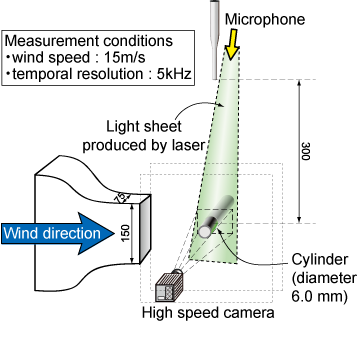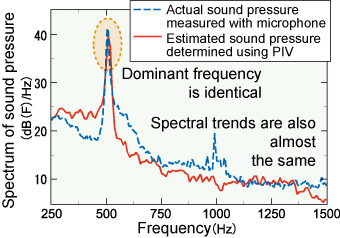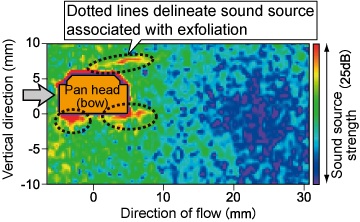4. Method for experimentally evaluating aerodynamic sound sources by measuring flow velocity distribution
- A method was developed to experimentally evaluate level of aerodynamic sound at given observation points and locate sound sources by measuring flow velocity distribution.
- The present method was confirmed as producing sound pressure estimations which correlated well with measured sound pressure.
Although existing methods to detect sources of aerodynamic sound can be utilized to analyse the position of the sound source, it is still particularly difficult to clarify the underlying sound generation mechanism. Therefore, by directly measuring the velocity distribution of air-flow and evaluating the location of sound source and noise level at given observation points, an experimental evaluation method was developed to make it possible to analyse the generation mechanism of the sound produced.
Flow velocity distribution was measured by adapting particle image velocimetry (PIV), which offers the advantage of being both contactless and having high temporal resolution, using a laser (Fig 1). By utilizing an evaluation formula appropriate for estimating aerodynamic sound produced by air flow and simultaneously increasing accuracy of flow velocity distribution measurement, it has become possible to grasp the characteristics of aerodynamic flow with considerable precision for frequencies up to 1.5kHz, for the 2D cylinder used in fundamental examination. Furthermore, it was verified that the estimated sound pressure yielded with the present method correlated well with measured sound pressure (Fig 2). In addition, on the basis of light polarisation property of a laser beam, a measurement method for 3D velocity distribution was developed, making it possible to simultaneously obtain the velocity distribution for two different planes. Results after application of the present method to a model pan head showed that it was possible to find the structure of the aerodynamic sound source, and the sound source distributing in the longitudinal direction of the bow (Fig 3).
By virtue of the present method, it has become possible to understand, through experimentation, the sound source distribution of a complex make-up by measuring flow velocity distribution, and it has become possible to analyse in detail intimate relationship associating aerodynamic sound and flow. In the future, this method should prove useful in the preparation of guidelines for designing noise-reducing measures.
 Fig. 1 Wind tunnel test schematic outline
Fig. 1 Wind tunnel test schematic outline Fig. 2 PIV estimated sound on 2-D cylinder compared with measured sound
Fig. 2 PIV estimated sound on 2-D cylinder compared with measured sound Fig. 3 Estimation of aerodynamic sound source distribution in the vicinity of the pan head using flow velocity distribution measurement
Fig. 3 Estimation of aerodynamic sound source distribution in the vicinity of the pan head using flow velocity distribution measurement